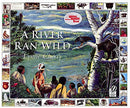Description
A River Ran Wild: An Environmental History explores the dynamic life story of a river ecosystem in New Hampshire from the distant past up to the present. Telling the history of a waterway introduces young readers to the ways human behaviour interacts on the natural environment. The focus of the story is the Nashua River in New Hampshire but the story could be told for any river located in North America. The river provides an ideal home to many animals, birds and fish. The first people to encounter the bounty of the river are the Algonquin speaking Nashua Indians who were searching for a village site. They named the river, Nashaway, meaning river with the pebbled bottom. These people made effective use of the river's resources and closely followed the rhythm of the season. They fished for salmon, collected cattails for their houses, and canoed on the river. The next part of the river's history is marked by the arrival of European fur traders. Following on their heels were more European settlers whose demand for farmland resulted in conflict with the Native People. The Native People were driven from their homeland and more settlers entered the river valley. At the turn of the century, the Industrial Revolution made its appearance on the river in the form factories, mills, and canals. As the factories developed their byproducts of waste were dumped into the river and the result was increased pollution. The river no longer could sustain the fish and wildlife that depended on the water. The river was dying. A descendant of the Nashua dreamed about the river's problems. From his dream he approached a friend with an idea for cleaning up the river's pollution. From this humble beginning a grassroots movement for environmental cleanup of the river was launched. Years went by and the communities along the Nashua rallied to return their once pristine waterway to its former glory. The movement was successful and the final images of the book portray a vital waterway that supports human and wildlife. The book is well researched and illustrated with detailed and accurate images of Native People, wildlife, and landscape. The author includes detailed notes about the actual Nashua River and its cleanup. Included are maps, border illustrations that support textual content and specific acknowledgements. This is an excellent resource for teachers who want to use a children's picture book to introduce science, environmental studies, art, reading, and social studies around the true story of a river. Lexile Level: 670; Guided Reading Level: P; DRA Level: 34-38.


